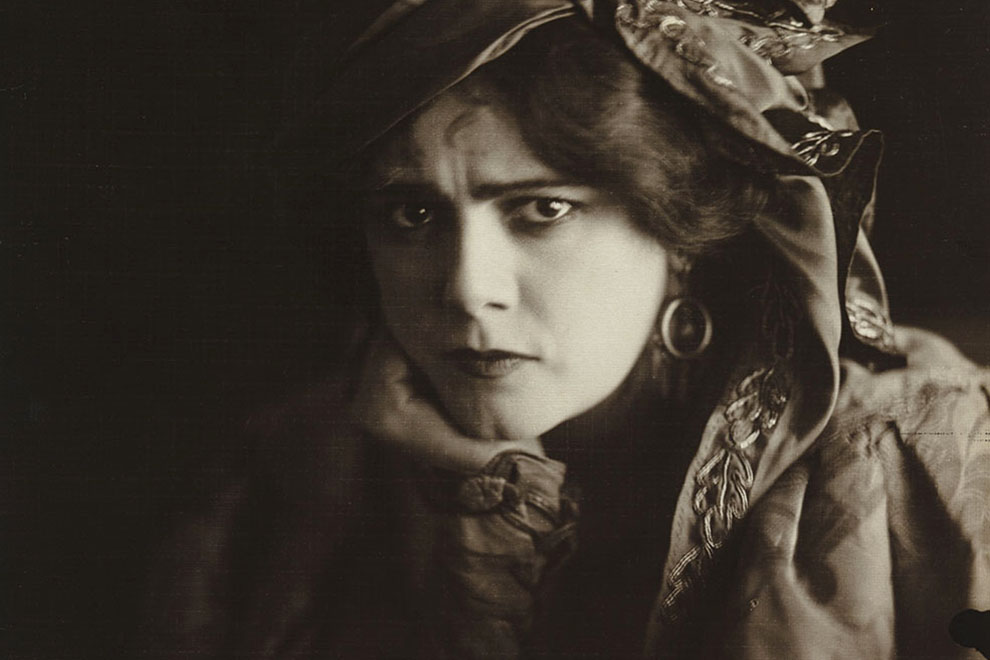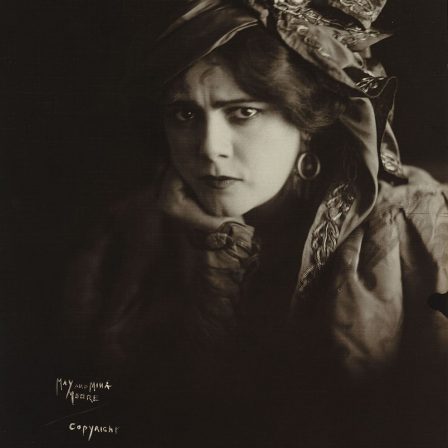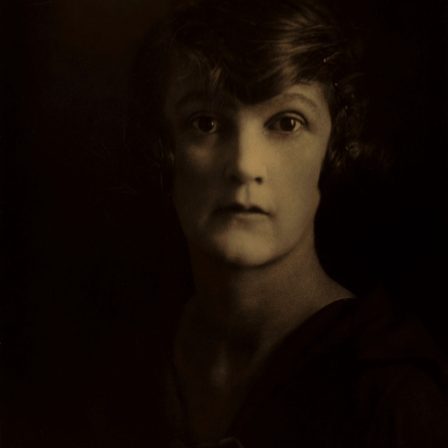In the summer of 1910 a young female photographer arrived in Sydney and took a room alongside the offices of that well-known weekly magazine, the Bulletin. May Moore was in Australia to see if she could build a business as successful as the one she and her younger sister Mina owned and operated in Wellington, New Zealand. Within two years Mina had joined her sister in Australia, running the Melbourne branch of the business while May stayed on in Sydney.
The sisters rapidly acquired reputations as brilliant portraitists working in a style they had developed well before they left New Zealand. A Moore photograph could usually be recognised by head-and-shoulders framing, the frequent use of “Rembrandt lighting” (the face lit from a single artificial source to one side, creating a triangle of light on one cheek), a pencil-thin streak of natural light highlighting the sitter’s profile, rich sepia tones, highly textured decorative mounts, and a likelihood that the subject was a performer or a writer.
May had nursed a passionate interest in theatre and the arts since her youth, and for the whole of the sisters’ careers this influenced their choice of studio location, pictorial style and subjects. May’s decision to set up temporarily in the same building as the Bulletin gave her instant access to the stream of writers, artists and liberal-minded politicians who visited the magazine. Her subsequent moves, first to George Street and then to King Street, ensured that the business was always adjacent to the city’s most important theatres, including the Grand Opera House.
The sisters’ decision to open their Melbourne studio in the new J. & N. Tait Auditorium at the Paris end of Collins Street was no less astute. The Tait brothers were theatrical entrepreneurs, and their building included a concert hall for operas, plays and orchestral concerts. Rehearsals and recitals brought a steady stream of people past Mina’s studio, many of them seeking promotional portraits. Over the next few years Mina’s trade expanded in line with the growth of an “arty” set attracted to that part of Melbourne by its wide, gracious boulevard, the paved flagstone paths fringed with busy clubs and cafes, and the recently relocated Georges department store, with its modish couture garments and copies of the latest Paris fashions.
The Moores’ contemporaries described them as typical “modern women.” They were seeking economic independence and social mobility in what was still considered an unusual industry for women. Even in America, which had experienced the greatest growth in the number of women opening their own photographic studios, women comprised less than 20 per cent of the profession. The Moores’ feminist sympathies were especially evident from their decision to employ men only as darkroom assistants, with women not only taking all managerial and executive responsibility but also wielding the cameras. And when Mina retired from the Melbourne arm of the business she sold it to Ruth Hollick, a woman noted for her feminist sympathies and activities.
Between them the Moores produced hundreds of stunningly beautiful portraits. Most were of Australia’s theatrical performers and leading writers, artists and politicians, as well as other prominent local and international celebrities. The list includes the stage actresses Lilian Birtles, Lily Brayton and Ada Reeve, silent movie actresses Sara Allgood, Dorothy Cumming, Dorothy Lowand Dorothy Dix, opera prima donna Maria Pampari, actors Graham Marr and Edmund Burke, Australia’s second prime minister Alfred Deakin, journalist Howard Ashton, painters Petrus van der Velden and Frederick McCubbin, writers Ted Dyson and Dame Mary Gilmore, poets Henry Lawson, Zora Cross and David McKee Wright, the artistic Lindsay brothers, and Hugh Ward, the famous American-born actor and theatrical entrepreneur who, along with Julius Knight – the most popular figure on the stage in Australasia – had urged May and Mina to make the move to Australia.
The Moores’ Australian venture was so successful that Mina was able to retire comfortably after less than eight years in business, at which point she married the poet-cum-businessman William Tainsh and began raising a family. Her photographs of hundreds of Australian first world war soldiers had added substantially to the sisters’ income between 1914 and 1918, making it a large factor in their financial success. Mina didn’t allow the soldiers’ military status to influence the quality of her work; in keeping with the sisters’ motto, each portrait was executed in the same style they used for stars. May also married; unlike her sister, she kept working, more out of love for her craft than from necessity.
What was it about the Moores’ approach to portrait photography that guaranteed their success over that of many of their rivals? And why was their work so appealing to many members of the public as well as to the artistic set? The sisters were working at a time when, owing to a vast expansion in the numbers of available commercial photographers, fortunes could no longer be made from the trade in ordinary photographic portraiture. Mass production of cameras and printing equipment meant that portrait photography was soon being practised by professional and unprofessional alike.
To survive in this highly competitive environment, ostensibly commercial portrait photographers like the Moores were compelled to offer their clients something special, which invariably meant a signature artistic style. With both originality and individuality at a premium, the realisation that photography could be as highly expressive as painting was often a key to success.
New cultures of modernity were also generating a large audience for images of celebrities. Many of the stage and screen celebrities photographed by the Moores were moving freely across the English-speaking parts of the globe as they sought out new appreciative audiences for their artistic skills, and this invariably brought them to the relatively new urban centres of Wellington, Sydney and Melbourne. The constant publicity that these stars received from the press meant that not only did serious art lovers like the Moores follow the lives of these celebrities, but many members of the general public did so too and they demonstrated their interest by snapping up the Moores’ photographs.
What fascinated the Moores was the human face and what it revealed of the sitter’s personality. This is hardly surprising at a time of growing interest in alternative religions, including the occult, and in the new field of psychology, with its focus on interiority and the psychic life. Also influential around this time were the Aestheticist and Symbolist movements, with their love of art for art’s sake and their rejection of what they saw as the inhospitable, uncaring world of “nature.” Perhaps what should surprise us is the fact that the Moores succeeded in making a comfortable living among this minority element in Australian society.
Among the many highly talented artistic subjects who visited the Moores’ studios was the famous British stage actress Lily Brayton. As the historian Veronica Kelly has written, Brayton’s flair for costume and stage design played no small role in setting the tone for the seasons’ fashions in Australia:
Brayton’s dresses were analysed and consumed as fresh material in the on-going Australian uses of fashion as a vital aspect of self-enunciation and social message… Flemington racecourse, no less than the Theatre Royal, was a public stage, [where] Brayton performed her social role as fashion icon with distinction and personal flair.
A glance at the Moores’ many photographs of actresses bears out these claims and confirms their photographic contribution to an emergent set of fashions based on the elegant and imaginative styles of the theatrical world. The Moores were at the centre of this development, writes Daniel Palmer, because they worked in the period when the influence of theatre costume on men’s and women’s fashions was at its most powerful. The sisters’ photographs of Brayton and other actresses appeared in women’s magazines such as Home as well as in widely circulated literary publications such as the Triad and the Lone Hand.
Brayton singled out the Moores to do all her publicity work in Australia, complaining that the local press was constantly privileging her beauty at the expense of her considerable business skills and remarkable talent for design. She herself never explained what it was that she liked about the Moores’ work, only that, “other things being equal, women can photograph women best.” Besides highlighting the lavishness of Brayton’s costumes and her physical beauty, the Moores emphasised her ability to convincingly play prominent female characters from literature and history. For example, in the famous full-length portrait of 1913 in which Brayton poses as Cleopatra, the overhead lighting falls on her powerfully out-thrust arms and on her sumptuous, Gustav Klimt–style costume, while her legendary lovely face is contorted by a look of feigned anger.
In another portrait from 1913, Brayton is captured playing the role of the unloved Helena in A Midsummer Night’s Dream, her statuesque body and pose providing the perfect foil for the long, graceful lines of her Roman-style toga, with one end hanging elegantly from a shoulder while the other trails delicately along the floor. Brayton, with her right arm thrust behind her head in a melodramatic gesture, is portrayed here as the consummate actress whose every move is aimed at arousing the audience.
A third image produced in 1916 captures Brayton’s facial expression as she plays yet another lead female role, glaring fiercely into the lens of the camera. (This photograph appears in full in the gallery accompanying this article.) By placing the actress against a pitch-dark background and highlighting only one side of her exotic-looking headpiece and her pallid face with its flashing dark eyes, May has captured the atmosphere of passion and intrigue that surrounded the world-famous actress and was one of her hallmarks. It was an effect that was further enhanced by having Brayton only half turn her head toward the camera, since this resulted in the other half remaining tantalisingly in shadow.
Another very colourful personality of the day photographed by the Moores was the woman who in 1923 was crowned Australia’s Queen of Bohemia. This was Dulcie Deamer, a fellow New Zealander (whose portrait appears in the galley above). Taken in 1920, the Moores’ photograph is not as well known as the famous shot taken by a press photographer in 1923 at the Sydney Artists’ Ball, which showed Dulcie wearing a stylish leopard-skin outfit. Nor can it be said to be one of the Moores’ most striking photographs in either an aesthetic or a technical sense. But it is significant for what it reveals of some of the more nuanced and less well-researched aspects of portrait photography in Australia as it emerged in the early years of the twentieth century, and in particular of the sort of personalised portrait photography that was evolving through women’s subjective responses to the more destabilising effects of colonial modernity.
Like the Moores, Dulcie had left her country of birth in order to seek fame and fortune on the international stage; like them she had ended up trying to make it as an artist in Australia. Born in Christchurch, she had already performed several times on stage and had experienced success when at age sixteen she won a prestigious writing competition advertised in the Lone Hand. When published, her winning story was accompanied by illustrations by Norman Lindsay. Less than a year later she was in New York, married to a Sydney-born theatre director named Albert Goldie, who had promised her a career on the stage and engagements in all the leading cultural centres of the world. Unfortunately for Dulcie, Goldie’s theatre company was soon bankrupt. Seven years and six children later the couple divorced and Dulcie was domiciled in Sydney writing journal articles, poems, plays and bestselling novels while her mother raised her children. Dulcie published a total of five novels of which the best known was The Sutee of Safa: A Hindoo Romance (1913) – a fanciful romantic tale partaking of exoticism and sensuality and featuring a passionate heroine who succumbs to a devastatingly handsome but imperious male.
The Moores’ portrait was taken by May when Dulcie, still with Albert, was thirty years old and living back in Australia. A silver-gelatin print carrying all the hallmarks of the Moores’ classic style, including the dramatic natural lighting and velvety sepia tones, it captures Dulcie’s vivacious, irrepressible spirit and something more besides. We see at the back of her striking dark eyes (she claimed to have Spanish and Italian blood) what can only be described as a slightly disconcerted expression, like that of a startled fawn caught in the glare of car lights and uncertain about which way to turn, suggesting that despite being talented, ambitious and extremely attractive there were still aspects of her life over which she had little control.
This returns us to the distinctive feature of the Moores’ style, often remarked on by critics, that sets their work apart from that of many of their contemporaries – their uncanny ability to capture something of their sitters’ thoughts and emotions in addition to their character or personality. What they have captured in Dulcie’s face is something resembling the fragile “lost” look of a person who, despite her best efforts, has not realised her ambitions and does not know why.
We do not know what May, as the photographer, thought of Dulcie, and the latter makes no mention of the sisters in her famous autobiography. Indeed, her only comment about photography was to say, “I’ve never kept photographs, they clutter up the place.” But the sisters may have recognised something of their own inauspicious origins in her life story, as well as something of their own female ambition. They too were from a small town in New Zealand, in their case Wainui, a tiny rural community situated near Wellington; and like Deamer, they had both pursued a career that did not sit easily with motherhood and which involved abandoning New Zealand for brighter lights. On the other hand, unlike her they had confined their ambition to Australia and to a craft with more obvious commercial potential than either acting or writing, and had consequently achieved greater success in both financial and artistic terms.
May and Mina Moore were among a minority of outstanding early Australian photographers who took their passion for art and theatre and used it to produce a thriving commercial practice. Not only did they photograph artists, writers, popular entertainers, actors and theatre people from different parts of the world at a time when new technologies were allowing people to travel faster and more freely across the globe, but they also used their skills to create portraits of well-known people who shared their own cosmopolitan tastes. The increasingly fluid boundaries of trade and the more expansive business and cultural opportunities that characterised colonial modernity meant that for a period of more than twenty years the Moore sisters were able to expand their business without having to move outside the elevated forms of art, the social circles and the kinds of subject matter that interested them most. •
This is an edited extract from Shifting Focus: Colonial Australian Photography 1850–1920, edited by Anne Maxwell and Josephine Croci, published by Australian Scholarly Publishing.






